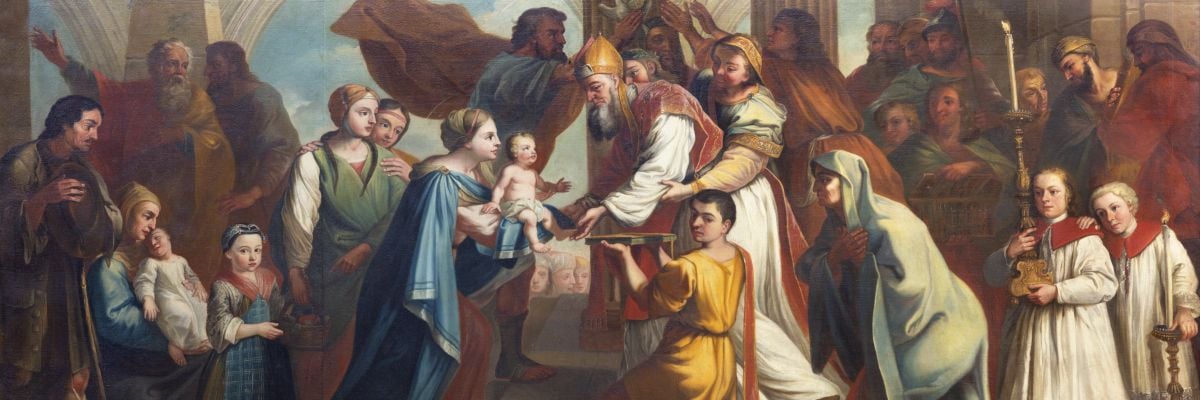
Homily for the Feast of the Presentation of the Lord in the Temple and of the Purification of the Blessed Virgin Mary
Rare it is that an immovable feast takes the place of a Sunday, but such is the case today. It is a feast of the Lord, and so that trumps a “green Sunday” throughout the year. Something similar can happen with the feast of the Transfiguration in August, or the Dedication of the Lateran Basilica in November.
Often enough one hears the question “When does the Christmas season end?” One might say that today’s feast, which takes place forty days after Christmas, is the furthest extent of the Advent-Christmas cycle. Mary and Joseph fulfill the last duties of faithful parents for the birth of their firstborn son and for his mother as prescribed in the Law of Moses. It is thus both a feast of the Lord—the Presentation—and of Our Lady—the Purification. The chants and readings of the feast refer to both aspects of the day.
Let’s take a look at its Marian aspect, which since the early middle ages has been important in the Western church.
Today, according the many Doctors of the Church, we celebrate Mary’s offering of her Son for his redeeming work, not only in his incarnation and his ministry, but most especially in his passion and death. Thus Holy Simeon prophesies, “And your soul too a sword shall pierce”—the sword of his undergoing the immense suffering of the Cross, “a sign which will be contradicted.”
The Catholic Church teaches the following deep and far-reaching truth about Mary’s share and active role in the salvation of the world through the redemption on the Cross in these burning and poignant words of the Second Vatican Council:
“The Blessed Virgin advanced in her pilgrimage of faith, and faithfully persevered in her union with her Son unto the cross. There she stood, in keeping with the divine plan, enduring with her only begotten Son the intensity of his suffering, joining herself with his sacrifice in her mother’s heart, and lovingly consenting to the immolation of this victim, born of her: to be given, by the same Christ Jesus dying on the cross, as a mother to his disciple, with these words: “Woman, behold your son.”
These are truly amazing words, teaching us that that God planned for Mary’s consent to form part of the offering of the Lord on the Cross. One of the Greek Fathers even calls her the “Virgin Priestess” because she provided the victim for the sacrifice and consented to it!
Mary’s share in the Lord’s saving work is of an altogether exceptional character, since she not only shared in the Passion offering after it was completed, as all Christians do through the sacraments (especially the Holy Mass), but she also, under Christ, accomplished the redemption in its historical reality. She was not only a spectator, but a participant in the salvation of our race.
The language of theology and of liturgy and devotion has stretched itself to its limits in describing and praising her surpassing role. The Eastern churches (and especially the Ethiopians, but really every one of the Eastern rites) perhaps go the farthest in their proclamation and praise of Mary’s presence and power as she shares with her Son the distribution of the fruits of their common struggle for our salvation from sin, death, and the evil one.
On this feast, right after the consecration of the Body and Blood of the Lord, that is of the Victim whom Mary brought forth and consented to offer, the Byzantine rite sings “O Mother of God, hope of all Christians, watch over those who have placed their hope in you!” Meanwhile the priest censes the Holy Gifts.
Let us bring Our Lady into our worship at Holy Mass, aware that she is not just an optional adornment of Catholic devotion, but rather the one from whose consent came both Christ’s incarnation and his redeeming death. Then we can pray to her with the greatest confidence and without any silly fear of going to far in our recognition of the greatness of the gifts we receive through her, namely, the very life and blood of her Divine Son, our Savior.



